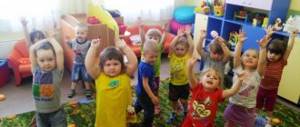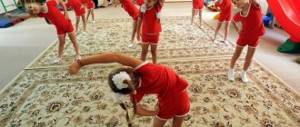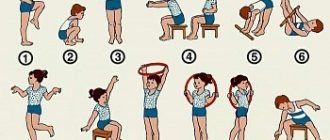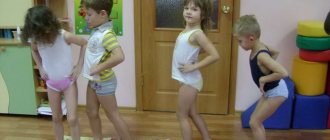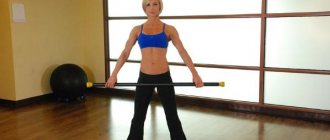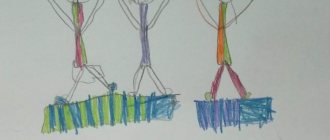Goals, objectives, principles and techniques of morning exercises in preschool educational institutions
Morning exercises are a set of physical activities selected in such a way as to warm up the muscles and stretch the skeletal muscles. By decree of the Ministry of Education and Science of the Russian Federation, exercise is included in the mandatory educational program of all kindergartens. The name of this type of physical education implies that it is performed after waking up in the morning, but at present there are practically no night groups in kindergartens in our country, so the exercises are carried out before breakfast, when the kids are already quite active. At the same time, those children who have already managed to run around and jump, thanks to moderate physical activity, will calm down a little, and inactive kids, on the contrary, will cheer up. Therefore, the primary goal is to organize preschoolers for further work, and not to awaken the body after sleep.
Morning exercises help children get ready for the rest of the day.
Goals
The main goal of morning exercises in preschool educational institutions is the formation and improvement of motor skills, maintaining and strengthening the health of preschool children. Morning exercises allow you to:
- strengthen the child’s motor system;
- carry out the prevention of developmental disorders of the musculoskeletal system (improper posture, scoliosis, flat feet);
- increase immunity;
- improve the functioning of the cardiovascular system;
- normalize breathing;
- increase performance;
- cultivate independence.
Tasks
To achieve the set goals in the process of daily exercises, the teacher, together with the children of the preparatory group, solves the following tasks:
- prepares the body of preschoolers for the coming day;
- teaches you to maintain correct posture in everyday life;
- trains children to maintain static and dynamic balance;
- develops coordination of movements and the ability to navigate in space;
- develops sports skills (speed, endurance, physical strength) and maintains children's interest in sports.
Morning exercises consists of 3 stages, each of which performs its own tasks:
- Introductory: organizing the attention of preschool children, developing coordinated actions, preparing the body to perform more complex exercises, forming correct posture and preventing flat feet.
- Main: strengthening the main muscles of the body, developing correct posture.
- Final: restoration of heart and respiratory rhythm, relaxation of the body after physical activity.
Principles and techniques
Children of senior preschool age require adherence to a number of didactic principles and a more careful selection of techniques that will allow them to efficiently and effectively implement the tasks of morning exercises, and most importantly, interest the children in doing exercises. The basic principles of morning exercises include:
- accessibility (all children can perform a specific exercise);
- gradualism (from simple to complex);
- visibility;
- plot;
- musicality;
- activity of students.
Within the framework of these principles, the teacher can implement various methods of conducting morning exercises.
Visibility
Visual perception of an image is the most powerful source of information accumulation in children. Therefore, it is important to organize the presence of pictures depicting children doing exercises, illustrations from famous cartoons, fairy tales with a suitable plot (for example, a frame where Uncle Styopa “quickly jumps up from the sofa, opens the windows wide” will help children form an idea of the correct start of exercises). In addition, the teacher shows all the movements by example.
At the initial stages of getting to know a new complex, the teacher helps the kids learn the information, showing all the movements by example.
Plot content
This principle lies in the fact that the teacher offers a set of exercises united by a single plot outline. You can do the exercises on behalf of the girl Masha, animals, or characters from books and films who find themselves in some unusual circumstances and are calling on the kids for help.
Story-based gymnastics helps all children perform exercises with interest
Musicality
You can do exercises both while counting and while listening to the sound of a tambourine to the beat or rhythmic music. Preschool children with great pleasure perform certain exercises with musical accompaniment. It is recommended to introduce it after the entire gymnastics complex and its individual elements are well mastered by the children. For the introductory stage, i.e. for walking, running, you can choose something energetic, with a cheerful rhythm; for jumping and jumping in the second stage - rhythms of a dance nature; for bending and smooth movements - monotonous, calm music; gymnastics ends with the same melodies.
Video: rhythmic gymnastics on step platforms
Gaming techniques
Being the leading activity for children, the game helps children become interested in the task, get involved in work faster and better remember movements and words. Here are some examples:
- "Hello, neighbor!" (Russian folk game). The one addressed answers: “Hello!” and jumps after the leader. The game ends when all children form one chain of jumping behind the leaders. Children must repeat the movements of the leader, the one who performs the movements inaccurately leaves the game, the movements must be varied: on the left leg, on jumps, on two legs, sideways, etc.
- "Cat and Birds" Children are running around the hall. At the command “Cat” the children run to the bench. The game is repeated 3 times.
- "Entertainer." One of the players is chosen as an entertainer and stands in the middle of the circle. The rest of the children, holding hands, walk in a circle to the right or left and say: “In an even circle, one after another, we walk step by step. Stay where you are, let’s do it together... like this.” The children stop and give up. The entertainer shows some movement, and all the children must repeat it. After two repetitions, another driver is selected.
Typically, games are used at the final stage of charging, but, if justified by the tasks, they can also be used at the introductory stage. The “replace me” technique also applies to play games, when children take on the role of a teacher conducting exercises. This technique can be used only when children are already quite familiar with the set of exercises.
Games are the best way to convey the essence of exercise to children
Poems
Children better remember movements that are commented on, so it is advisable to use rhymes when carrying out a set of exercises.
Table: examples of exercises in verse
| Subject | Rhymes |
| Winter | Children, line up in order for a fun exercise. To stretch our legs, we will walk along the path. But the path is not easy, It carries us along (walking). It’s frosty outside, so that your nose doesn’t freeze, you need to stomp your feet (stomp) and clap your palms (clap). Along the path, along the path We jump on the right leg And along the same path We jump on the left leg (jumping). We'll all go skiing, we'll climb the hill. The sticks will help us walk, The road will be easy for us (they walk with long strides). And there are snowdrifts all around. The roads were covered with snow. Do not get stuck in the field so that we raise our legs higher (hands on the belt, raise the knees). Let's run along the path and reach the lawn. White flakes are flying, It has become colder. Only, winter-winter, you didn’t scare the guys (running). Snowflakes are falling from the sky, like in a fairy-tale picture. We will catch them with our hands and show them at home to mom (walking, clapping hands above our heads). On the fluffy snow We started a game. You are a snowball and I am a snowball, stand in a circle, my friend. One, two, three, four, move the circle wider (form in a circle). I’m not afraid of frost, I’ll make strong friends with it (hug yourself with your arms). Frost will come up to me, Touch my hands, touch my nose (touch my hands, touch my nose), So I must not yawn, Jump, run and play. To become strong and agile, let's start training. I pull my head to my shoulder, I want to stretch my neck. To the sides once or twice I shake my head. We put our fingers to our shoulders, We will rotate our arms. Circle forward, Another circle forward, And then vice versa. We stretch our shoulders, We move our hands towards. One hand flies up, and the other goes down for now. Body to the right, body to the left, We need to stretch our back. We will make turns and help with our hands. It's easy fun. Turns left and right. We also stretch the back and bend it back and forth. We bend down easily, reaching the floor with our hands. They sat down and stood up, they sat down and stood up, it was as if they had become Vanka-stand up. Let's squat one, two, three, Don't mess around, look. And now everyone stood up together and began to jump. One, two, three, four, five, Let's jump and gallop. Now let's walk together and walk everything in place. Inhale through your nose and exhale through your mouth, Breathe deeply, and then Step on the spot slowly, And the weather is good. We walked along the paths, jumped and galloped. And now it’s time to go home, to our dear kindergarten (walking). We warmed up from the heart and rush to the place again (forming in a line). Although the exercise is short, we warmed up a little. Let all the white snowflakes fly into our room. We are not cold at all, we are doing exercises. |
| Spring | Children, line up in order for a fun exercise. To stretch our legs, we will walk along the path. But the path is not easy, It carries us along (walking). We walk one after another through the forest and green meadow. One-two, one-two, Here is a birch tree, here is grass, Here is a clearing, here is a meadow, Walk more cheerfully, my friend (walking). We came to the edge of the forest, Raising our legs higher. Through bushes and hummocks, Through branches and stumps (walking with high knees). We have a nice posture, We put our shoulder blades together, We walk on our toes, And then on our heels. Let's walk easily, like little foxes, And like a clumsy bear, And like a gray wolf-wolf, and like a cowardly bunny. We have miracles in the world, Children became dwarfs, And then we stood up together, We all became giants. And now we are streams, Let's run in a race. We run straight to the lake, The lake will become big. The weather became warm. The sun is shining, and nature has awakened from sleep, spring has come to visit us (running). April, April, Drops are ringing in the yard. Streams run through the fields, There are puddles on the roads. The ants will come out soon after the winter cold (walking). On the lawn in the morning We started a game. You are a daisy, I am a bindweed, stand in our wreath. One, two, three, four, move the circle wider (form in a circle). To become strong and agile, let's start training. What follows is a set of exercises. Now let's walk together and walk everything in place. The sun rose early in the morning and caressed all the children. Strokes the chest, strokes the neck, Strokes the nose, strokes the forehead, Strokes the ears, strokes the arms (movements according to the text). A warm breeze blew, Sh - Sh - Sh, the leaves rustled (breathing exercises, performed 2 times). A cold wind blew from - C - C, the wind died down, the leaves did not rustle (head lowered, tilted, arms relaxed). We walked along the paths, jumped and galloped. And now it’s time to go home, to our dear kindergarten. We warmed up from the heart and rush to the place again. (Building) Exercise is useful for everyone! Everyone needs charging! She saves us from laziness and illness! |
| Author | Bogatykh Svetlana Alexandrovna |
| Quote from: https://www.maam.ru/detskijsad/utrenja-gimnastika-v-stihah-zima-vesna.html | |
Carrying out morning exercises in the middle group
Practicing morning exercises occurs in 3 stages.
Table: timing of stages of morning exercises
| Stage | Goals | Types of exercises | Time |
| Introductory |
|
| 1–2 minutes |
| Basic |
|
| 2–3 minutes |
| Final | Restoring blood pressure and pulse. |
| 1–2 minutes |
Balance training exercises are included in the main stage of gymnastics
Table: example of a summary of plot gymnastics in the middle group (fragment)
| Author | Kiseleva T., teacher at MBDOU D/s No. 64, Ivanovo. |
| Introductory stage | Q: Guys, do you know the Russian folk tale “Teremok”? (Yes). Do you want to help the animals build a little house? (Yes). Then go ahead! |
| Main part | Children line up in one line.
Q: Are the kids tired? (No). Let us stand together in a circle and build a “teremok”...> |
| The final stage | <… Game “Teremok” (based on the play by S. Ya. Marshak) Children perform movements in accordance with the text.
|
| Quote from: https://www.maam.ru/detskijsad/konspekt-utrenei-gimnastiki-v-srednei-grupe-624288.html | |
Video: complex of plot exercises “Winter” in the middle group
Video: complex of morning exercises in the middle group
Types of exercises and rules for exercising in kindergarten
As already noted, morning exercises are part of the physical education program in a preschool educational institution. Exercise can include various types of exercises:
- accompanied by music (either an abstract musical background or songs that describe all the actions that the kids must perform);
- plot gymnastics (all tasks are united by a common plot, often one character acts, for example, exercises with Crocodile Gena or Masha);
- exercises with objects (massage balls, dumbbells, sandbags, plumes, etc.) that stimulate the interest of children;
Sultans are often used to perform gymnastics
- work on simulators (for example, step platforms);
- play gymnastics (based on a combination of play techniques, that is, built in the form of a game, for example, the quest “Help sister Alyonushka find brother Ivanushka,” in which children complete tasks and find a character);
- exercise in bed (a form of lazy exercise that is done after naps or in preschools with overnight groups).
It is recommended to include elements of 2–3 types in your daily set of exercises. To train fine motor skills and improve the health of the respiratory system, 1-2 exercises for the breathing apparatus and elements of finger gymnastics are performed.
This is interesting. In many methodological sources, the types of gymnastics described above are classified as non-traditional types of exercise.
The traditional form of gymnastics involves the use of general developmental exercises.
Requirements for morning exercises
The Federal State Educational Standard (FSES) defines the requirements for morning exercises in kindergarten:
- Exercises are performed in a well-ventilated room or outside. In hardening groups, children do exercises in the fresh air in any season.
- If the complex involves exercises on the floor, then you need to use special gymnastic mats.
- Hardening groups complete the gymnastics by dousing them with water.
- Dress code for charging: things made of hygroscopic fabrics, comfortable shoes or socks.
The main requirement for clothing for gymnastics is comfort and practicality.
- The order of completing tasks is observed: first stretching, then walking, gradually acquiring a running pace, breathing exercises, tasks to warm up the muscles of the arms and shoulder girdle, sedentary play.
- Suitable rhymes and musical accompaniment are selected.
- In a combination of dynamic and static exercises, the former has an advantage.
Class on morning exercises at a preschool educational institution, card file of exercises
The duration of a complex of physical activity before breakfast for children 6–7 years old is about 12 minutes. For children in the preparatory group, all tasks are performed 7–9 times, sets of jumps are repeated 3–4 times. The basic pose is toes apart, heels together.
Exercises of one complex include tasks on:
- training the muscles of the shoulder girdle, arms;
- development of flexibility of the spine and back muscles;
- strengthening the abdominal muscles, legs and arch of the foot.
Lesson time plan
Taking into account the need to include tasks that comprehensively affect the body, when developing a complex for 2–4 weeks, the teacher distributes this work between 3 stages:
- introductory part (walking, formation in ranks, columns) – 1 minute;
- the main part (swinging arms and legs, squats, running) – 8–9 minutes;
- the final part (carried out in the form of a game at a moderate pace and/or walking) – 2 minutes.
Table: card index of thematic sets of exercises
| date | Stage | Exercise name | Progress |
| September | Introductory | Warm-up | Walking in a column one at a time: 10 s ─ walking, arms to the sides, 10 s ─ walking, arms up, 10 s ─ walking, arms to the sides, 10 s ─ walking, arms down, walking on heels, running in all directions, normal walking in a column. Formation in 2 columns. |
| Basic | "We met» | IP: basic stance, spread your arms to the sides, smile, say “Ah!”, then lower your arms. Repeat 5 times. | |
| "Up down" | I.p.: standing hands forward. On the count of 1, the right hand is up, the left hand is down, on the count of 2, vice versa. Repeat this exercise 6-8 times. | ||
| "Tilts to the sides" | I.p.: standing, hands on the belt. Lean to the left, I.p., and then do the same to the right. Repeat 3 times. | ||
| "Bends to the floor" | IP: standing, feet shoulder-width apart. On the count of 1-2 - tilt, try to touch the toe of your right leg, do not bend your legs, 3-4 ─ return to I.P., 5-6 ─ tilt, try to touch the toe of the right leg, 7-8 ─ return to I.P. . | ||
| "Springs" | I.p.: basic stance 8-10 half squats, spreading your knees to the sides, raise your arms, bent at the elbows, hands represent lanterns. | ||
| Final | Completion | Walking in a column one at a time “Do exercises in the morning, You will be strong, you will be brave!” | |
| October | Introductory | Warm-up | Walking in a column one at a time, walking on your toes, walking on your heels, running in all directions, regular walking in a column. Formation in 2 columns. |
| Basic | "Sunflower" | IP: standing, arms along the body. Hands up, right leg back ─ on toes, inhale. Return to IP, exhale. Hands up, left leg back - on the toe, inhale. Return to IP, exhale. Repeat this exercise 2-3 times. | |
| "Width height" | IP: standing, arms down, feet shoulder-width apart. On the count of 1–2 ─ arms ─ to the sides, inhale, 3–4 — return to IP, exhale, 5–6 ─ arms — up, inhale, 7–8 ─ return to IP, exhale. Repeat this exercise 3-5 times. | ||
| "Reels" | IP: standing, arms to the sides. On the count of 1–4 ─ rotate the hands forward, 5–8 ─ backward. Repeat the exercise 1-2 times. | ||
| "Squats" | IP: standing, arms down. On the count of 1 ─ sit down, arms ─ forward, back straight, do not lift your heels off the floor, 2 ─ return to I.p. Repeat this exercise 6-8 times. | ||
| "Tilts" | IP: standing, feet shoulder-width apart. On the count of 1-2 - tilt, try to touch the toe of your right leg, do not bend your legs, 3-4 ─ return to I.P., 5-6 ─ tilt, try to touch the toe of the right leg, 7-8 ─ return to I.P. . Repeat 4 times. | ||
| Final | Massage game | Exercise is useful for everyone (run the fingers of both hands across the forehead from the middle to the temples 4 times), Everyone needs exercise (run the index fingers along the wings of the nose 4 times), it saves us from laziness and illness (running in place). Walking in a column one at a time. | |
| November | Introductory | Warm-up | Walking in a column one at a time, walking on your toes, slow running, fast running, walking in all directions, regular walking in a column. Formation in 2 columns. |
| Basic | "The bugs have flown" | IP: legs in a “narrow path”, arms with a crown at the bottom. Execution: raise your arms up through your sides; shake the plume - “the beetles flew”; lower through the sides down. Lowering your hands, say: “W-w-w-w.” Repeat 5 times. | |
| "Wings" | I.p.: legs are spread wide apart, arms with a crown are lowered down. Execution: bend forward; straight arms to the sides - “wings”; straighten up. Repeat 4 times. | ||
| "Beetles" | I.p.: lying on your back, arms along the body, crown in one hand. Execution: on the word “bugs” quickly bend and straighten your legs raised up; on the word “sleep” - lower your arms and legs. Repeat 3 times for 5-10 seconds. | ||
| "Grasshoppers" | IP: legs in a “narrow path”, arms with a crown at the bottom. Execution: 8–10 grasshopper jumps, alternating them with walking. Repeat 3 times. | ||
| Final | Game "Sun and Cloud" | On the command “Sun” the children run scattered around the hall, on the command “Cloud” they crouch down and clasp their heads in their hands. The game is repeated 3 times. Walking in a column one at a time. | |
| February | Introductory | Warm-up | Walking in a column one at a time, walking on your toes, walking with high knees, running in all directions, regular walking in a column. Formation in 2 columns. |
| Basic | "Nimble Squirrel" | IP: basic stance, tilt your head to the right, hands on your waist. Return to I.p., 3,4 - the same to the left. Repeat 6 times. | |
| "Nimble Hare" | I.p.: standing, feet wider than shoulders, arms up. Bend forward, touch your heels on the inside with your hands. I.p. Repeat 7 times. | ||
| "Fast Wolf" | I.p.: basic stance, hands on the belt. Raise your right leg forward, take it back, raise it forward again, etc. Repeat 4 times. | ||
| "Cunning Fox" | IP: standing on your knees and palms, head raised. Arch your back, lower your head, return to I.p. Repeat 4 times | ||
| Final | Completion | Form into a column one at a time. Run in all directions, stopping and completing the task “Imagine an animal.” The teacher names the animal, and the children show it using movements, gestures and facial expressions. Walking in a column one at a time. | |
| Quote from: https://infourok.ru/kompleksi-utrenney-i-bodryaschey-gimnastiki-dlya-detey-sredney-gruppi-1699652.html | |||
Example of a gymnastics lesson before breakfast
| Author | Chernova Tatyana, teacher-organizer of preschool educational institution No. 57, Kostroma |
| Name | “Summary of morning exercises in the preparatory school group “Magic Sultans” |
| Lesson stage | Content |
| Introductory | We lined up in order for morning exercises. They caught up, pulled themselves up and smiled at each other. Right one or two. Step march! Hands up, walk on your toes. Hands on the belt, walking on the heels. Running gallop. Take a step and restore your breathing. Inhale, exhale! Now hurry up, stand in three columns. |
| Basic |
|
| Final | And now you will form a column one at a time and, holding the plumes in your right hand above your head, will walk through. Everyone is healthy, everything is fine, Children: Thanks for the morning exercises! |
| Quote from: https://www.maam.ru/detskijsad/konspekt-utrenei-gimnastiki-v-podgotovitelnoi-k-shkole-grupe-volshebnye-sultanchiki.html | |
Complex 1
Warm-up
- Forming in a line, checking posture.
- Walking one after another in a column one at a time.
- Walking on toes, hands on the belt.
- Walking with legs raised high.
- Run at a slow pace in a column one at a time.
- Running scattered and in a column.
outdoor switchgear
- I.p. - basic stance, hands on the belt.
- 1 – arms to the sides;
- 2 – arms up and rise on your toes, reaching for your hands;
- 3 – arms to the sides;
- 4 – i.p.
- I.p. - Spread your feet shoulder-width apart, arms to the sides.
- 1 – bend over with a turn so that your right hand touches the toes of your left foot.
- 2 – i.p.;
- 3 – similar tilt in the other direction;
- 4 – i.p.
- I.p. - basic stance, hands on the belt.
- 1 – bring your arms forward, sit down (keep your back straight);
- 2 – i.p.;
- 3 – 4 – similar.
- I.p. - basic stance, arms down.
- 1 – raise your arms up, put your right leg back on your toes, bend over;
- 2 – i.p.;
- 3 – move your left leg in the same way;
- 4 – i.p.
Completion
- Jumping alternately on one leg.
- Jumping on both legs.
- Walking in place.
- Breathing exercise “Inhale (stretch, raise your arms up to your sides) - exhale (bend over, lower your arms).
Charging analysis and diagnostics
All elements of the educational process in kindergarten require careful analysis and diagnosis, and gymnastics in the morning is no exception. The purpose of this monitoring is to assess the effectiveness of measures taken by the teaching staff of the kindergarten to preserve the health and strengthen the immunity of preschoolers, as well as to create a positive emotional background in subsequent activities.
Morning exercises lift the mood of both children and adults for the whole day
The teacher is recommended to conduct an analysis after finishing work on a set of exercises, that is, 1–2 times a month.
At the beginning the following points are indicated:
- name of the preschool institution and group;
- teacher's name;
- date of gymnastics;
- children's age;
- number of children in the group.
Table: sample analysis scheme for morning exercises
| Lesson stage | Equipment | Activities of a teacher | Children's activities | Techniques used | Number of exercises | Job completion time | Conclusion (whether the goal was achieved or not, whether all the children did it, whether they met the time limit) |
| Introductory | 1 minute | ||||||
| Basic | 8–9 minutes | ||||||
| Final | 1–2 minutes |
